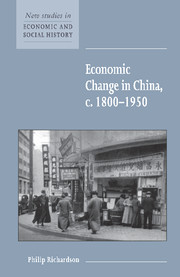Book contents
- Frontmatter
- Contents
- List of maps
- Acknowledgements
- Note on references
- Guide to pronunciation
- Dynastic chronology
- Weights and measures
- Map 1: China: provinces and cities
- Introduction
- 1 Analytical frameworks
- 2 The eighteenth-century legacy and the early nineteenth-century crisis
- 3 Growth and structural change
- 4 Foreign trade and investment
- 5 Industry: traditional and modern
- 6 Agriculture
- 7 The state and the economy
- 8 Conclusion: the legacy of the past
- Bibliography
- Index
- New Studies in Economic and Social History
- Previously published as Studies in Economic and Social History
- Economic History Society
8 - Conclusion: the legacy of the past
Published online by Cambridge University Press: 05 June 2012
- Frontmatter
- Contents
- List of maps
- Acknowledgements
- Note on references
- Guide to pronunciation
- Dynastic chronology
- Weights and measures
- Map 1: China: provinces and cities
- Introduction
- 1 Analytical frameworks
- 2 The eighteenth-century legacy and the early nineteenth-century crisis
- 3 Growth and structural change
- 4 Foreign trade and investment
- 5 Industry: traditional and modern
- 6 Agriculture
- 7 The state and the economy
- 8 Conclusion: the legacy of the past
- Bibliography
- Index
- New Studies in Economic and Social History
- Previously published as Studies in Economic and Social History
- Economic History Society
Summary
In the period under review China can be characterised, in essence, as a land-scarce but labour-abundant agrarian economy confronting the limits of its pre-modern base (both socio-economic and technological) and being drawn into contact with an industrialising West. Whilst there is now a deeper and more satisfying understanding of the complex process of change which that context framed and helped to determine, the precise outcome in terms of the creation of a modern growth economy remains uncertain.
There is no doubt that the period witnessed a considerable expansion of output or that, over time, output growth matched that of population. Nor is there any disagreement that a modern industrial sector was created during the first third of the twentieth century, and on a scale sufficient to underwrite a future socialist industrialisation programme. The incorporation of Western technology, the adjustment of a variety of Chinese business practices and the emergence of new facilitating institutions had enabled the transition to urban, mineral energy-based industrialisation to take hold, at least in certain areas.
However, whilst growth at the aggregate level cannot be ruled out, neither can it be proved. Although the creation of capitalism with Chinese characteristics was well under way it had come too late for modern industry to assume a sufficiently large quantitative role in the economy to compensate for any lack of growth in the dominant agricultural sector prior to 1937.
- Type
- Chapter
- Information
- Economic Change in China, c.1800–1950 , pp. 98 - 104Publisher: Cambridge University PressPrint publication year: 1999



